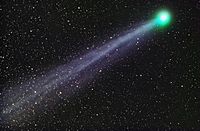C/2014 Q2 (Lovejoy) facts for kids

C/2014 Q2 as imaged 19 January 2015
|
|
| Discovery | |
|---|---|
| Discovered by | Terry Lovejoy 0.2-m Schmidt (Q80) |
| Discovery date | 17 August 2014 |
| Orbital characteristics | |
| Epoch | 18 January 2015 |
| Perihelion | 1.29077 AU (q) |
| Eccentricity | 0.99811 |
| Orbital period | ~11000 years inbound (Barycentric solution for epoch 1950) ~8000 years outbound (Barycentric solution for epoch 2050) |
| Inclination | 80.301° |
| Last perihelion | 30 January 2015 |
C/2014 Q2 (Lovejoy) is a special comet that travels a very long path around the Sun. It was found on August 17, 2014, by an amateur astronomer named Terry Lovejoy. This was the fifth comet he had discovered! When we see it, it often has a beautiful blue-green glow.
Contents
What is Comet Lovejoy?
Comet C/2014 Q2 (Lovejoy) is known as a long-period comet. This means it takes a very, very long time to orbit the Sun. Its journey around the Sun can last thousands of years. This comet was named after its discoverer, Terry Lovejoy.
Discovery of Comet Lovejoy
Terry Lovejoy found this comet on August 17, 2014. He used a special telescope called a Schmidt–Cassegrain telescope. It was about 0.2 meters (8 inches) wide. He spotted the comet in the southern sky, in a group of stars called Puppis.
When he first saw it, the comet was very faint. It had an apparent magnitude of 15. This number tells us how bright an object looks from Earth. Higher numbers mean the object is fainter. So, 15 is quite dim, meaning you needed a good telescope to see it.
Why Does it Glow Blue-Green?
One of the most amazing things about Comet Lovejoy is its blue-green glow. This special color comes from tiny pieces of the comet. As the comet gets closer to the Sun, it warms up. This causes ice and other frozen materials on its surface to turn into gas.
These gases include organic molecules and water. When sunlight hits these gases, they fluoresce. This means they absorb the Sun's energy and then release it as light. The specific types of molecules in Comet Lovejoy create its unique blue-green color. It's like a natural light show in space!
Its Journey Through Space
Comet Lovejoy travels on a very long, oval-shaped path around the Sun. It takes about 11,000 years to complete one trip around the Sun when it's heading inwards. After it passes the Sun and starts moving away, its path changes slightly. It then takes about 8,000 years to travel outwards.
The closest it gets to the Sun is called its perihelion. For Comet Lovejoy, this happened on January 30, 2015. At that point, it was about 1.29 AU from the Sun. An AU is the distance from the Earth to the Sun. So, it was a bit further from the Sun than Earth is.
See also
 In Spanish: C/2014 Q2 (Lovejoy) para niños
In Spanish: C/2014 Q2 (Lovejoy) para niños

